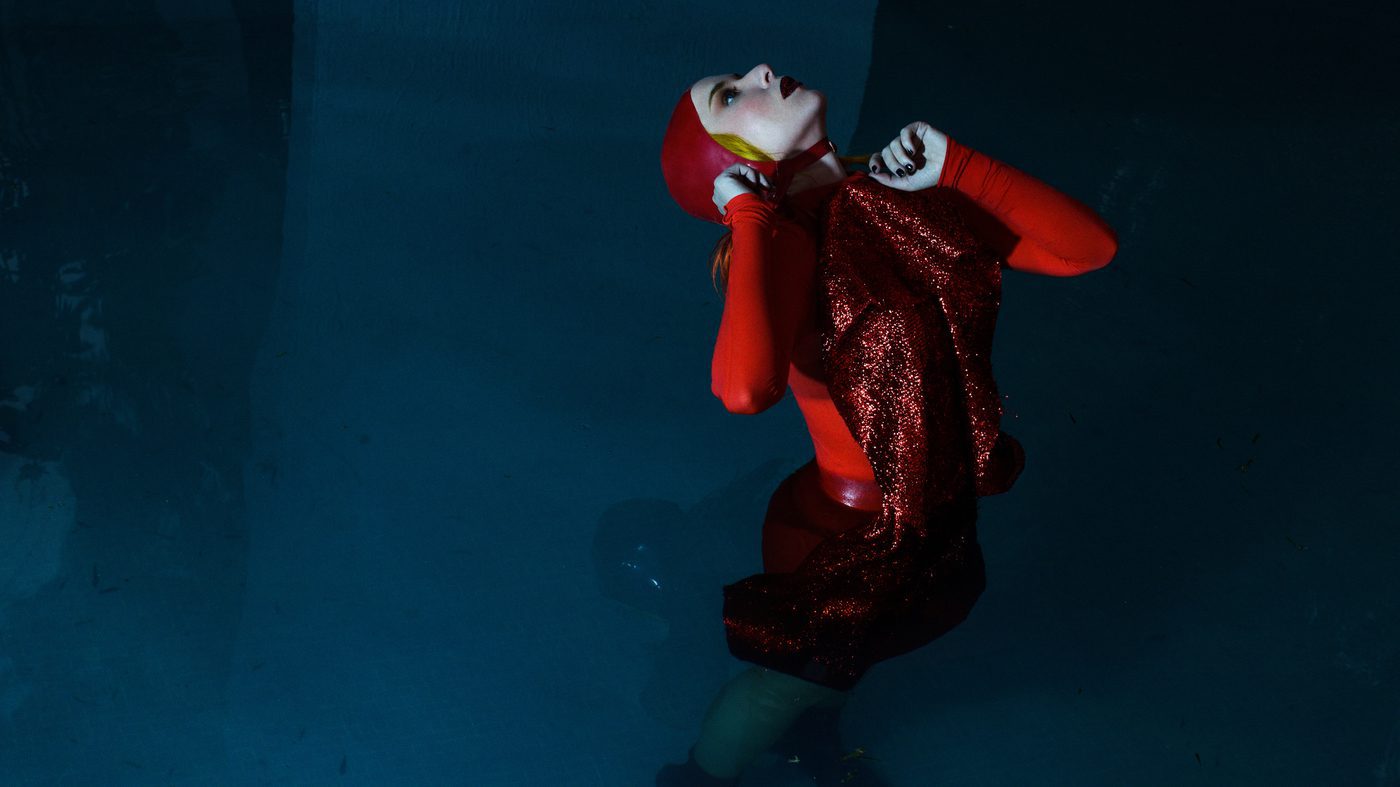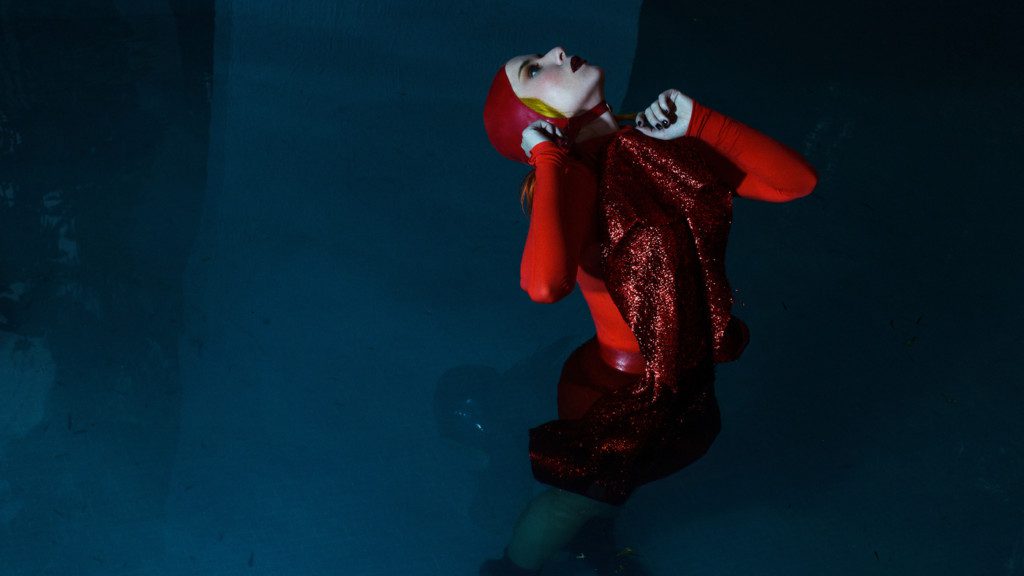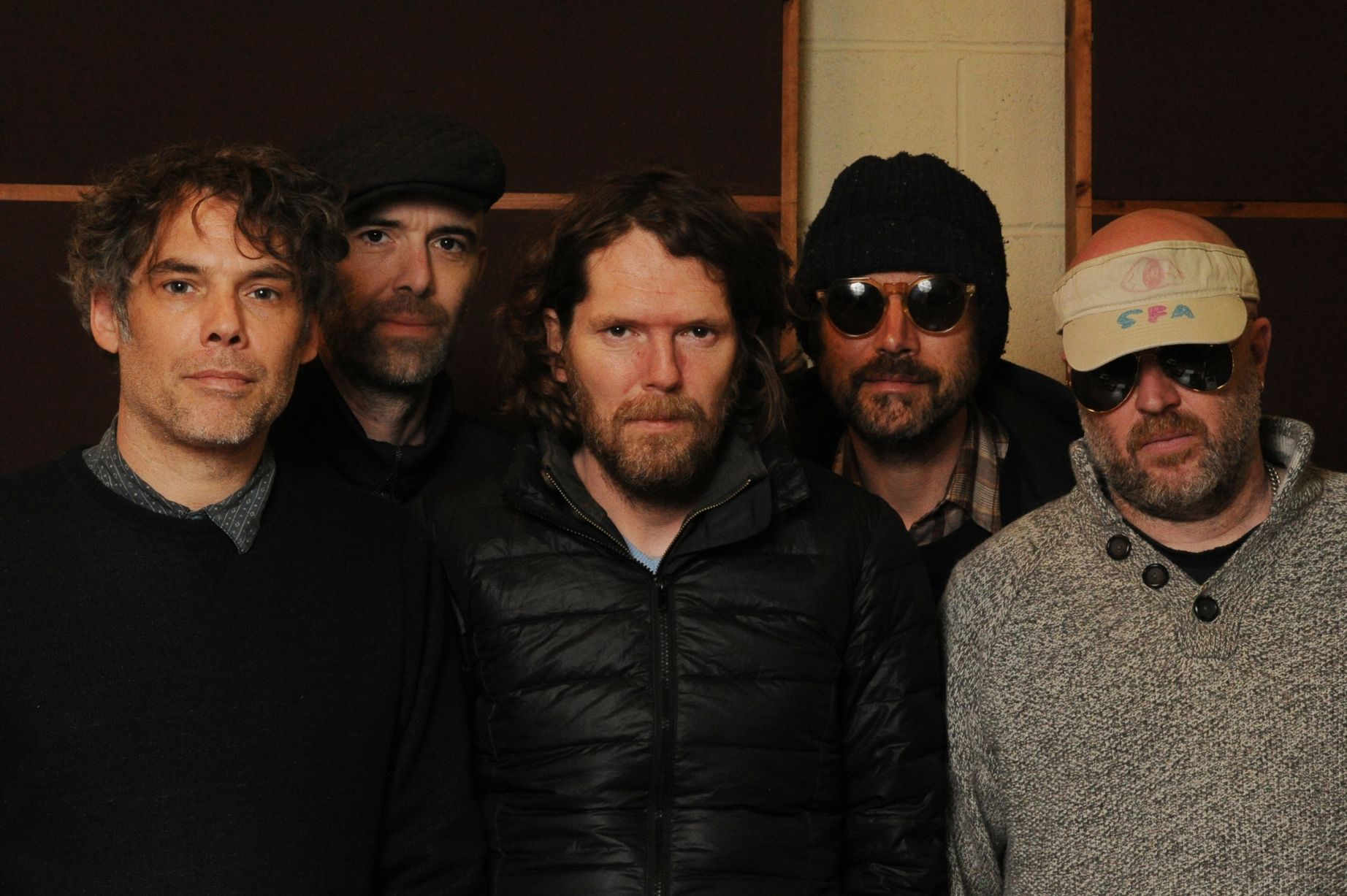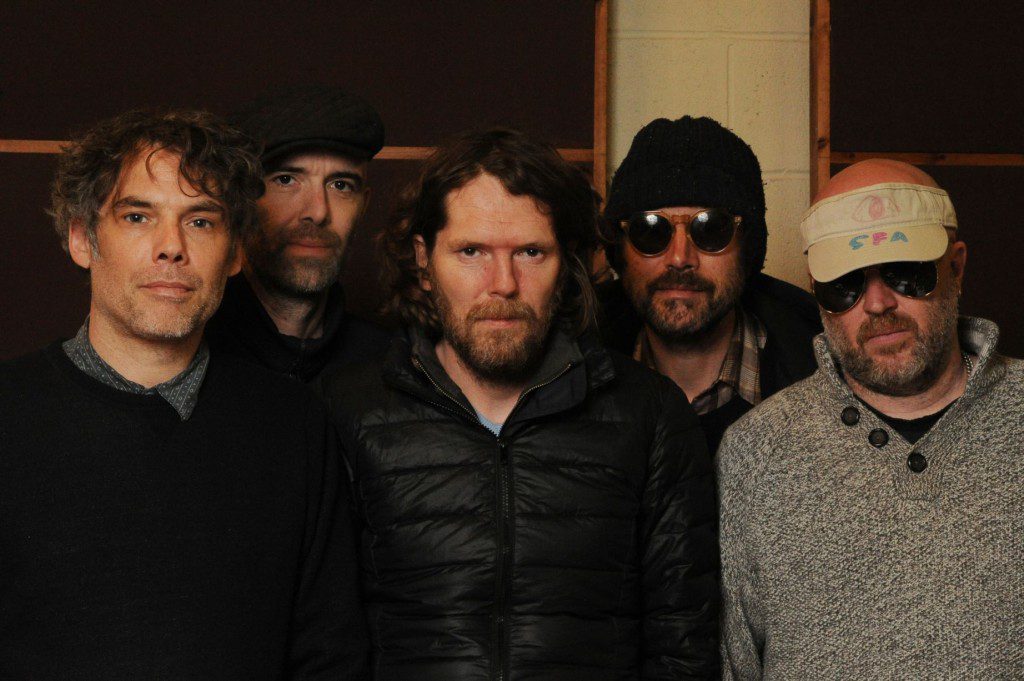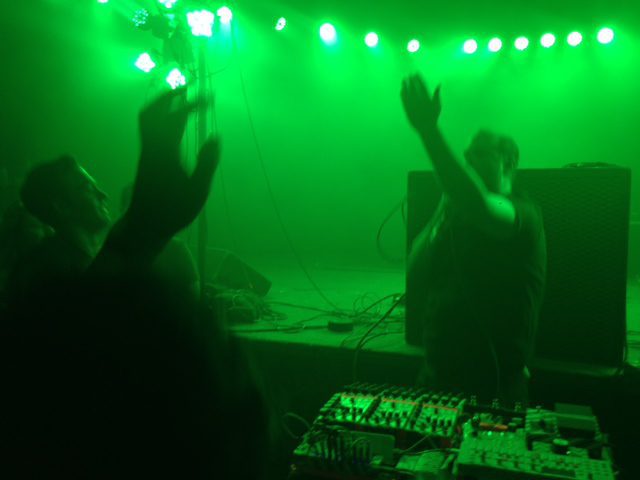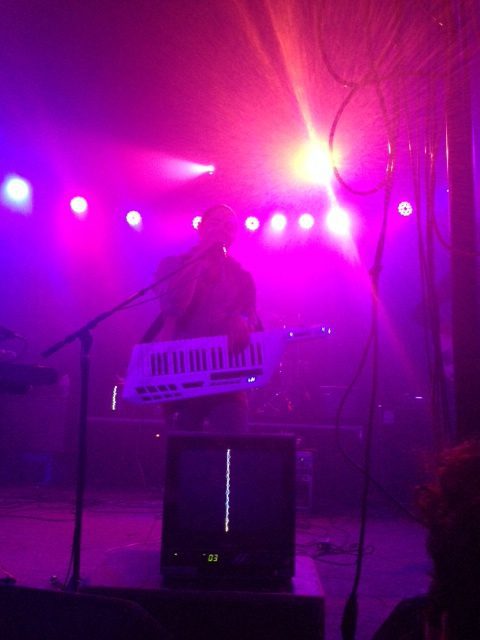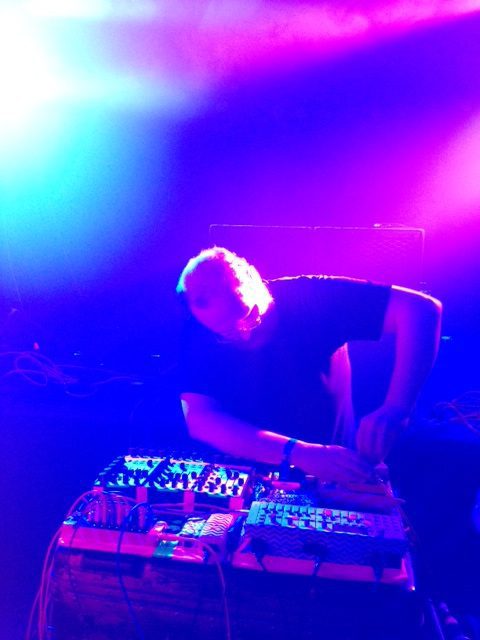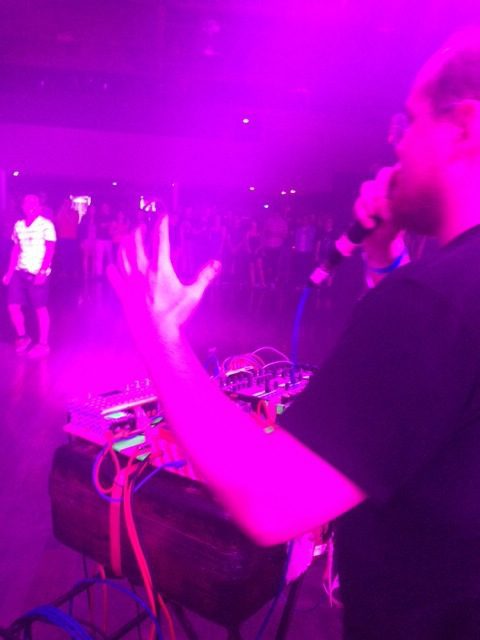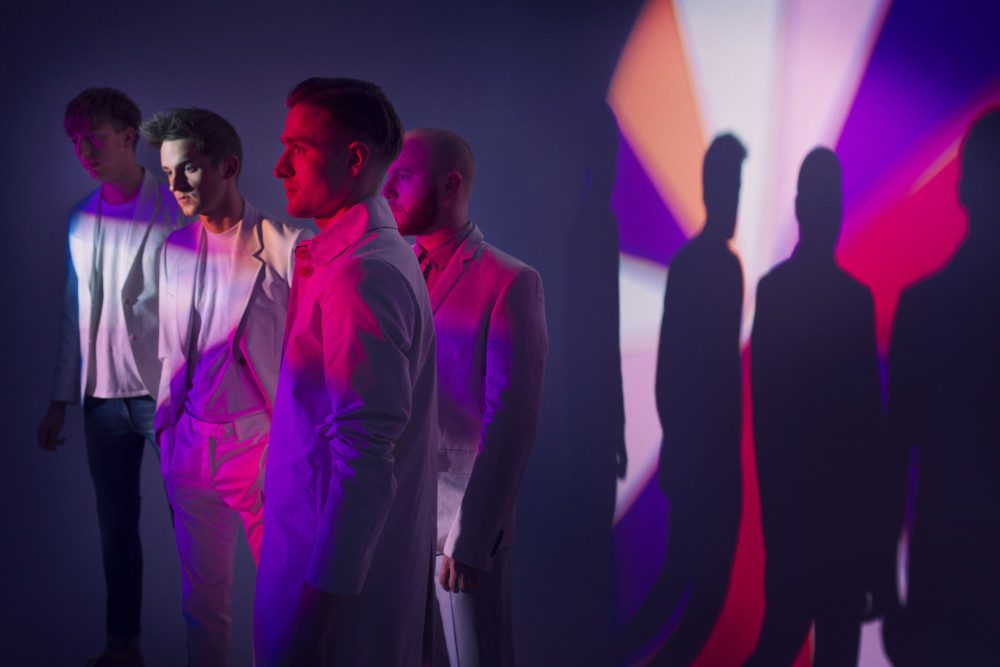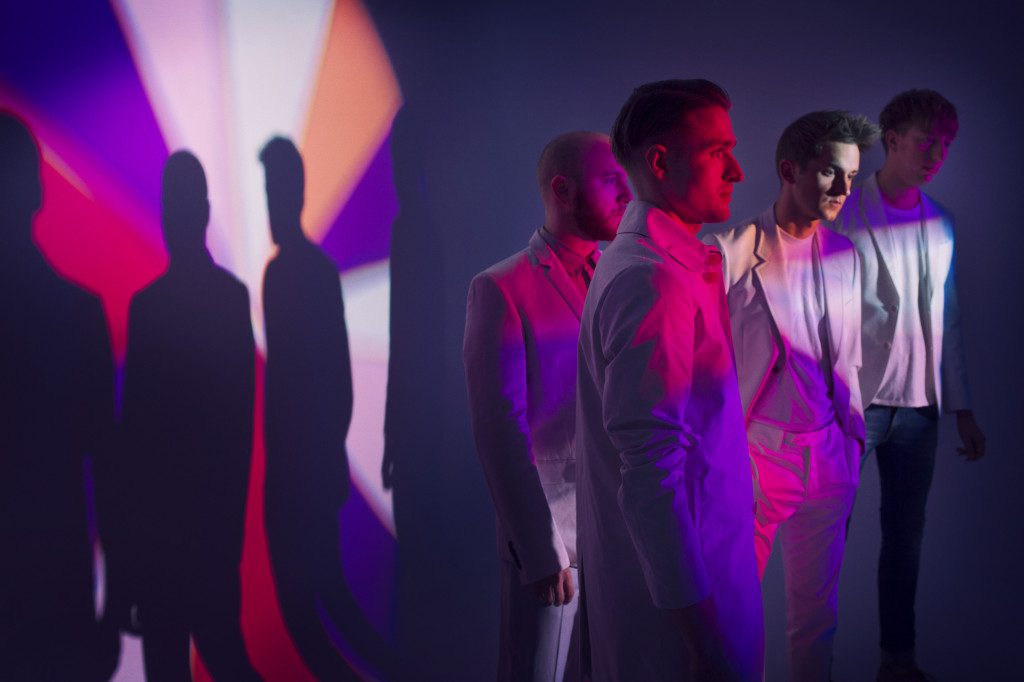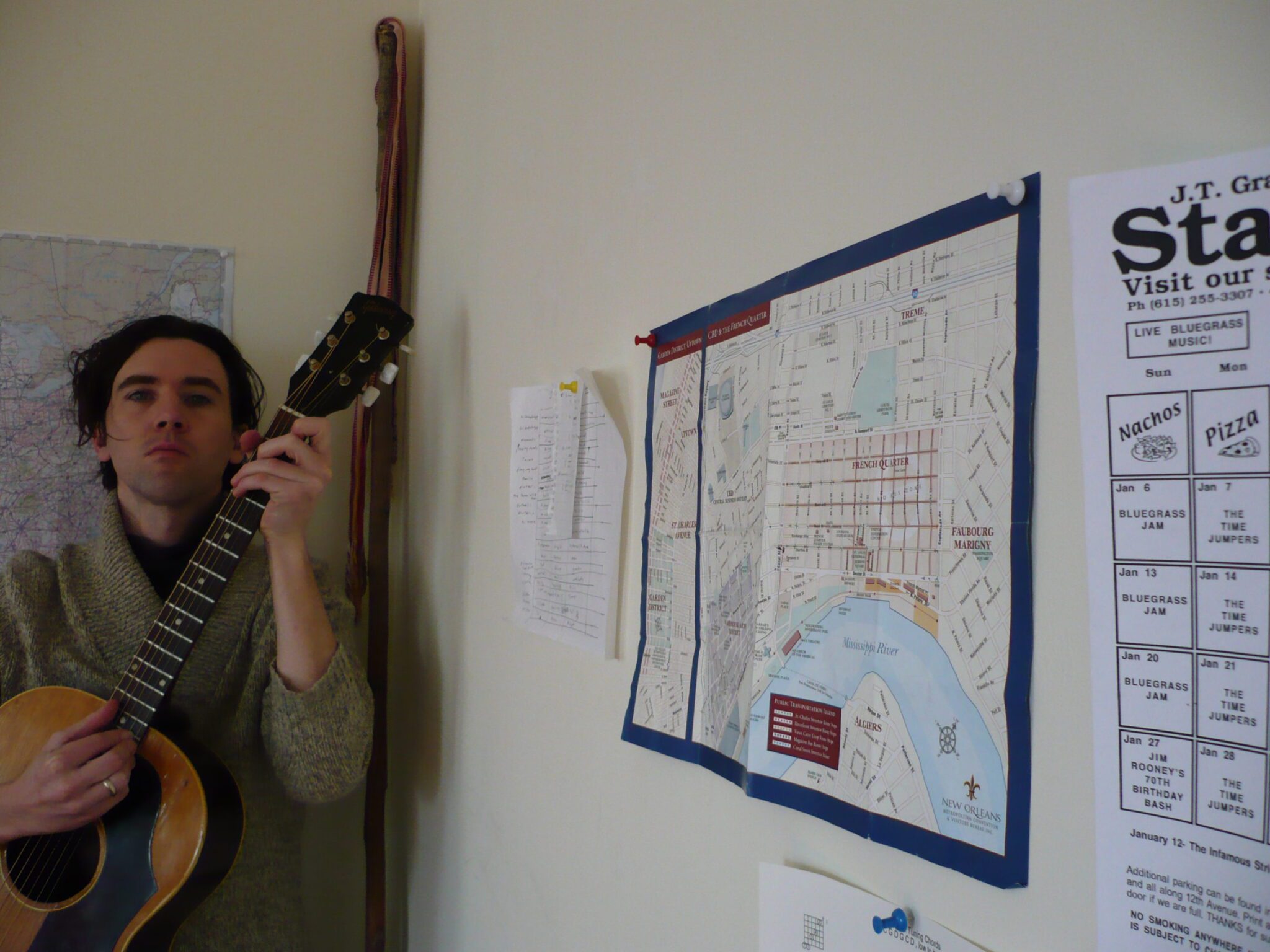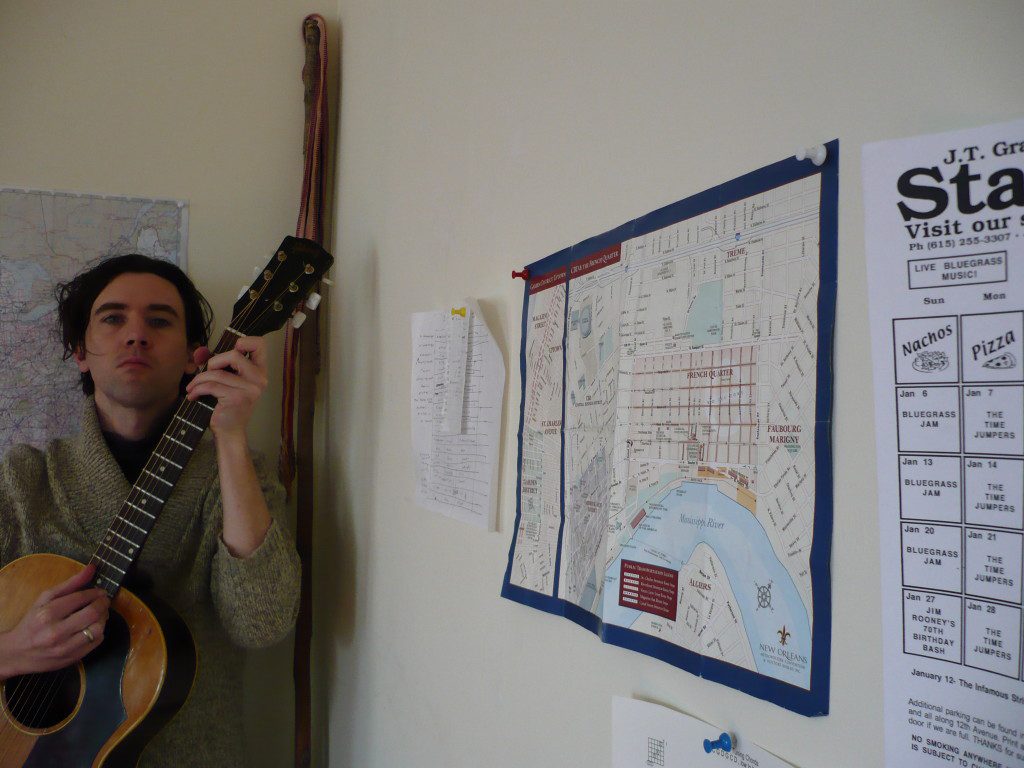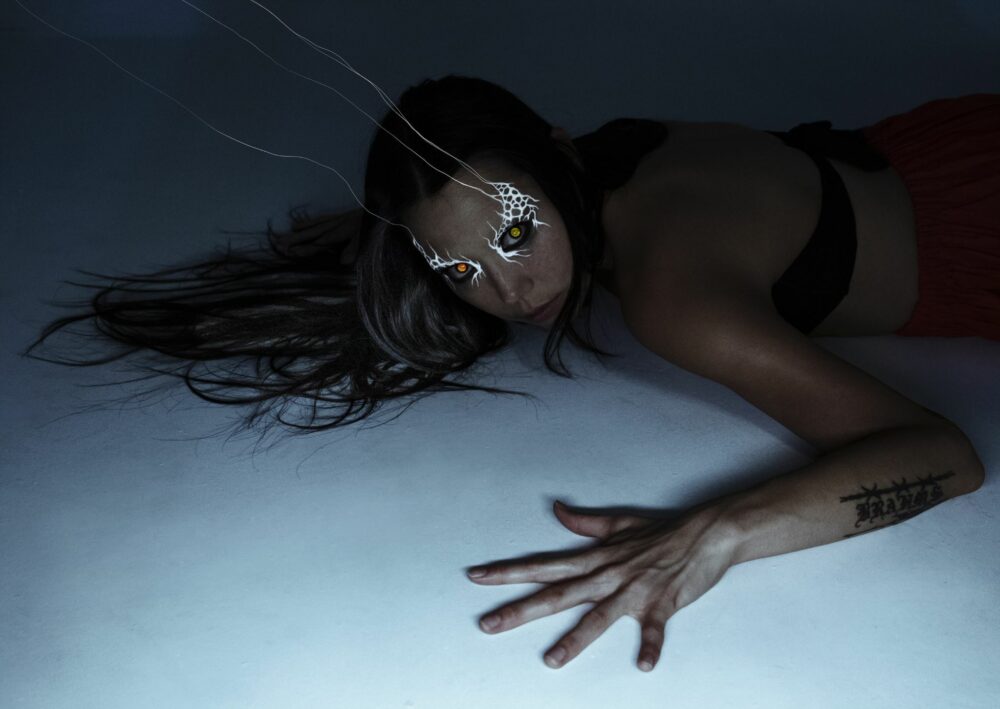
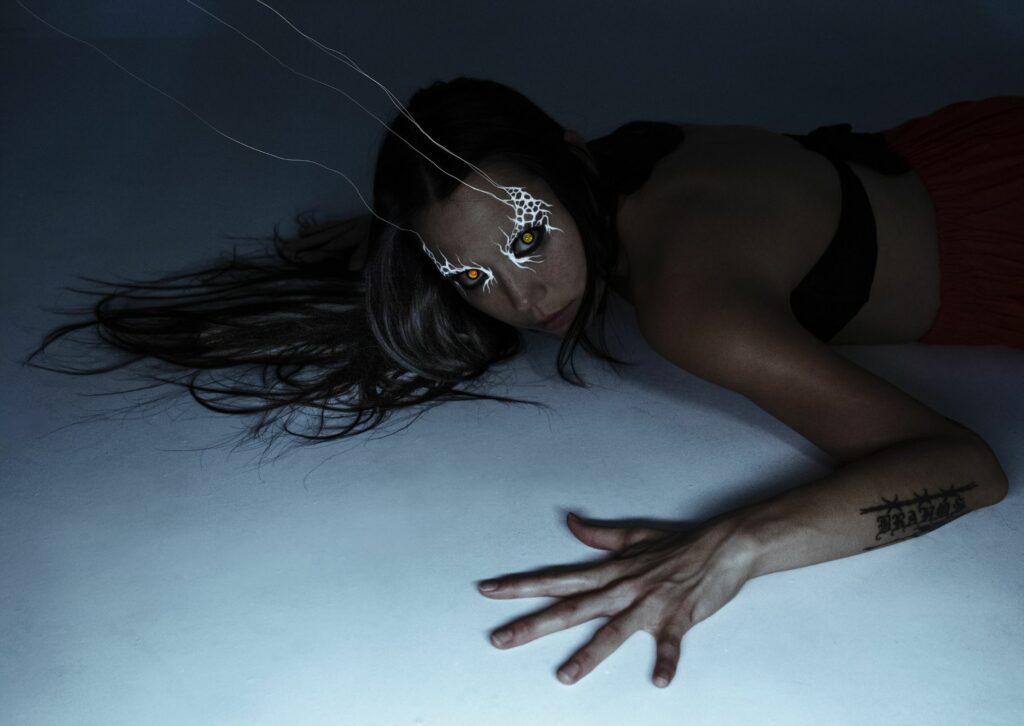
The writhing, bloody-mouthed woman-monster illustrating Sasami Ashworth’s sophomore album Squeeze is fearsome but familial. As the musical, lyrical and sensory terrain of her latest album divulges, the Californian singer-songwriter has been digging into her past, her mother’s family history, and discovering generations of capture, imprisonment, racism and displacement. The fury that emerged was only compounded by her own experience of being put in her place by techies on tour.
“I went into making this album with the intention of making a heavy rock album because touring the first album with mostly a queer femme band, I was met with a lot of toxic male sound person energy: questioning our abilities and knowledge of our instruments, and always asking us to turn our amps down. Inherently, that just manifested in me being more chaotic and turning my amp up louder, becoming more aggressive. I knew this chaotic, restless energy that’s on Squeeze was already bubbling on my first album tour,” she explains.
Ultimately, Squeeze (out February 25th via Domino Records) manifested as eleven tracks of macabre industrial and hypnotic sonic textures. Sasami produced most of it herself, with acclaimed garage rocker Ty Segall co-producing on a couple of tracks. “Ty is so strange and funny and goofy and bizarre, a perfect collaborator,” Sasami says. COVID restrictions limited who she was able to work with, but they are a fine roll call nonetheless: her studio partner Kyle Thomas (King Tuff) co-engineered and composed; Christian Lee Hutson and Hand Habit’s Meg Duffy added guitar and encouraged Ashworth’s folksier leanings. None other than Megadeth’s drummer Dirk Verbeuren rumbles in devilishly on a number of heaving, grinding bangers, including opening track “Skin A Rat,” a snarling, metal-industrial grinder built on militant drums, a tidal storm of crushing guitar riffs and the sing-song, suggestive refrain about three quarters in: “There are many ways…to skin a rat.”
Ghosts of Nu Metal weave their spectral fingers throughout the album, never more so than on “Say It.” The savage, distorted percussion (courtesy Moaning’s Pascal Stevenson, aka Fashion Club) is softened by Sasami’s soothing, calmly collected voice, even as a chilling mechanical refrain, disembodied and hollow, assures “Everything’s okay/Lie to me/Why don’t you rip it off?” There’s a resignation in Sasami’s sultry, cool response: “I don’t want you to apologize, just say it, say it, say it.”
She insists that there was no one person, nor one experience that inspired each of the songs. They were designed to be malleable to a spectrum of listeners, contouring to whatever personal grievances and ideologies they needed to hear echoed back to them, or expunged in cathartic howls.
“Whereas my first album is very autobiographical and diaristic, I built this album thinking way more about how a listener would use the songs to have an emotional cathartic experience, or creating art that echoes an emotional sentiment…” she explains. “I really wanted to make music that could soundtrack anyone’s, not just my own, experience of wanting to process frustration, rage, disappointment or anger, whether it’s systemic oppression or personal unrequited love or lack of communication. The main through-line I’m exploring is what if I, instead of trying to brighten my negative mood or get bogged down by sadness, leaned more into frustration, rage and violence? Then, in a fantasy kind of way, I’m able to burn some of that excess rage or frustration.”
The snaking, malevolent bass chugging away, skewered by shredded guitar fizzing like broken power lines on “Need It To Work” sounds like an action hero theme song warped and misshapen, eminently more interesting than a Bond song. But she nimbly evades pigeonholing by situating “Need It To Work” next to the ’90s folky-grunge-country of “Tried To Understand,” which channels some big Liz Phair and Sheryl Crow energy. “Feminine Water Turmoil” is a whole mood in itself, a rising tide of strings that surges and builds before transitioning into album closer “Not A Love Song,” in which Sasami’s lovely, yearning voice radiates over the surface like a sunrise over wide expanses of ocean. “I tried to turn it into something so profound/It’s not a love song/Just a beautiful, beautiful sound,” she sings, and it is beautiful and profound, with the timeless quality of a Celtic ballad.
“I wanted to build the album more like a movie or a haunted house as opposed to being one long mood or meditation. There are different scenes or rooms on the album,” Sasami says of the constantly shifting soundscape on Squeeze. “It was definitely a risk… [I was] trusting that my voice was enough of a through-line to connect it. I very intentionally put some slap bass and distorted guitars on some of the songs that, within a certain genre, wouldn’t always have that. ‘Call Me Home’ is a mashup of folk, synth-pop and heavier rock all mixed up into one song. It was a very intentional experiment in putting things together that don’t always go together.”
She had years of musical training, live touring, studio composition, recording and production experience to rely upon when going out on a limb. A 2012 graduate of the Eastman School of Music, Sasami started out as a composer of orchestral arrangements for film, screen commercials and other artists’ albums. From 2015 she played synths for scuzzy-rock band LA band Cherry Glazerr, before pulling up anchor and setting sail as a solo artist at the beginning of 2018.
From the get-go, her solo tracks won industry acclaim from the likes of Pitchfork and The Fader. She toured with – amongst others – Mitski, Soccer Mommy, Snail Mail and English indie band Menace Beach. Exactly twelve months after going solo, she released her self-titled debut. Singles “Jealousy” and “Free” (featuring Devendra Banhart) only solidified her reputation for tight arrangements, a light hand on production, and a nuanced appreciation for the interplay of hard and soft, organic and machine, violence and sympathy. Though it sounds very different from her debut, the rogue experimentation of Squeeze could not have happened without SASAMI introducing her to a dedicated audience.
“It comes from a place of being super grateful to have gotten attention on my first album, humbled knowing that people will listen to this album,” she confirms. “The instrumentals all came first on this album. Music in itself is a language and I wanted to tell stories with the instruments first, then find lyrics and words that tap into the same emotional world that’s being built. That’s why I was drawn to nu metal and classical music, because they’re so contrasting and so extreme. I wanted to create a feeling of whiplash, a chaotic environment, very intentionally.”
Traversing the extremities of sound and emotion was not without cost, but Sasami is candid about the realities of working within such revered and fiercely protected genres. “That was hard for me, to be shameless. It’s so easy to be insecure and worry about what people will think about your choices, especially [when] metal and certain realms of rock are gatekept and very white cis male-centered,” she says. “It’s scary to put yourself out there and even put yourself in the same world as that music, knowing very well that women of color are the most criticized artists in a lot of ways and held to a certain standard that other people aren’t.”
Ashworth is a descendent of the Zainichi people on her mother’s side, a diaspora of ethnic Koreans who lived in Japan during Japan’s occupation of Korea from 1910 to 1945. The descendants of the Zainichi – the second largest ethnic minority in Japan – are still systematically oppressed in present-day Japan. The word “Zainichi” is Japanese, meaning a foreign citizen “staying in Japan,” implying only temporary residence and inherently reminding people of their outsider status for generations.
“I grew up understanding a little bit that my mom had a difficult time as a Korean person in Japan,” Sasami remembers. “But growing up, especially being a typically Asian-looking person in a white neighborhood in America, I was so obsessed with assimilating into Caucasian culture that I wasn’t digging into my mother’s history.”
The pandemic circumstances provided her with the time to do a deep dive into her family’s mixed Korean and Japanese history and culture. “Being in America during 2020, while we were going through this extremely intense cultural reckoning about racial identity and inequality, it’s natural that it pushed me to do more research about my family’s heritage and my personal identity and how I connect with my family’s historic identity,” Sasami says. “Zainichi people chose to either claim their Korean identity despite oppression or assimilate more into Japanese culture.”
In reconnecting to her roots, Ashworth stumbled upon stories of the Japanese yōkai folk spirit Nure-onna (translation: wet woman) and was immediately awe-struck by this mysterious water creature, emboldened by how Nure-onna was feminine and noble, yet powerful and vicious enough to brutally destroy victims with her blood sucking tongue.
The album artwork weaves together Sasami’s historical, personal tapestry, just as her skillful balancing of sonic elements draws you in to Squeeze: sweet, sour, grinding and gristle, dramatic, melodious and deeply feminine. There is something earthly in it, in the pared-back, stoic nature of her voice contrasted with the heavily treated, warped harmonies that snarl in and around her. There’s a darkness, too, though it is not so much horrifying as a curiosity, like the vampiric deity with the head of a woman and the body of a snake that adorns the album cover.
“My mom’s youngest brother – he actually passed away recently – was an anime artist, producer and director, so when I wanted to build this fantasy avatar for my album cover, it made sense to draw inspiration from that,” Sasami says. “I connected with Andrew Thomas Huang, who has collaborated with fka twigs, Bjork, and Charli XCX, and he was down to find inspiration from Japanese and Korean folk tale characters.”
Sasami’s Nure-onna avatar has been modified with crab-style legs in respect to her Cancer star sign, and despite the bloodied mouth, the creature – like Ashworth – is captivatingly beautiful in all its diverse meanings and nuances. “I was actively experimenting, trying to push genre… to marry something so harsh, industrial and heavily aggressive with a texture that’s more intimate and personal. I think that all humans have such a range of emotions and characters that all these contrasting elements fit together, and it’s very human to have these super contrasting things within one body,” she says.
Sasami is humble and candid in conversation, wearing the hats of artist and observer just as skillfully as she juggles production and songwriting. But thematic heart of Squeeze is a self-assurance, and a validation that our fantasies and realities must exist beyond judgement, only inviting awareness and curiosity. “I think it’s a very human thing to want to feel powerful while maintaining some sort of beauty and femininity,” she reflects. “It’s about ownership as opposed to what’s right or wrong… being honest with how you feel, what you want to be, and who you want to be.”
Follow Sasami on Instagram and Facebook for ongoing updates.

